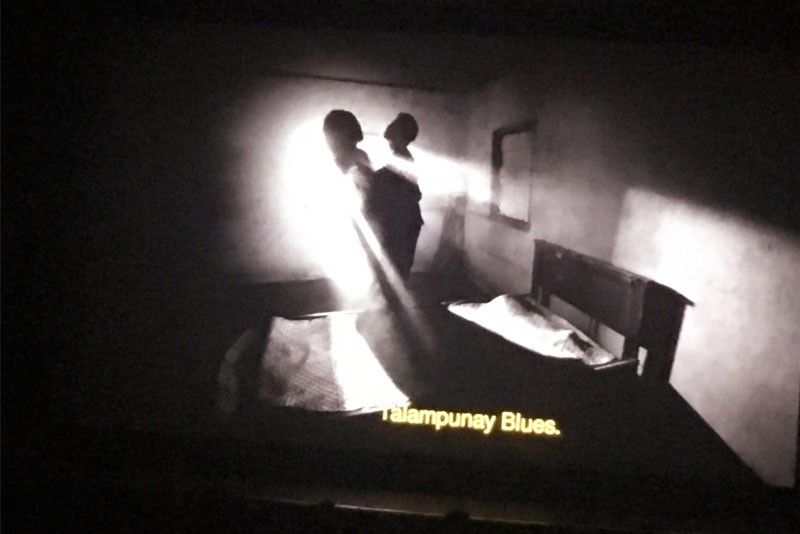Segments of appreciation, total admiration


(To be concluded)
If as a reader you appreciated William Gaddis’ cult novel The Recognitions, which was totally constituted of dialogue… If you can claim to have suffered minimal befuddlement with James Joyce’s Ulysses… Then you may be privy to that wavelength that welcomes Lav Diaz’s critically rewarded efforts.
The analogy can only be literary, initially, since Diaz’s filmmaking proceeds from a literary perspective: allegorical mythification to narrative span, scope, and mystification.
His latest, Ang Panahon ng Halimaw, won four awards in the Berlin Filmfest last December. It had its local premiere recently, at UP Diliman’s Cine Adarna. Following are segments (or fragments) of my appreciation:
• An empty street, or alley, or forest trail. A human figure appears at the farthest point, and begins making its way to the camera, or past it. Repeat with every third or fourth scene, as variations of setting.
• Yes, he renders much of filmmaking’s challenges moot since he eschews traditional film language that employs quick cutting, or a mix of establishing shots to close-ups, panning, tracking, the dolly....
• The theater gets increasingly cold. My seat is by an aisle on the very last row, closest to the exit doors that lead quickly to the men’s room.
• Easy editing, we may add, as it only requires threading through extended static scenes. Decide on a location, frame the shot this way, apply dramatic lighting, and simply have the characters work through their blocking and dialogue in as languid a pace as possible.
• An hour into the film, I take my first pee and smoking break, the last by that corner of the brick wall where a paper sheet’s sign reads: Ishmael Bernal Gallery. Beside an arrow: This Way. I wonder what Ishma would have thought, and articulated in his ringing baritone, about Lav Diaz’ films.
• Going back in, I run into Pinky Amador, consummate theater artist. We take a couple of doufies. I tell her she’s an hour late. No, she’d been watching from an upper gallery, and just made her way down to the theater floor. I mutter something like “I still have to establish your character’s relation to the rest of the narrative thus far.”
• Pinky plays a wild-haired woman who forages in the forest for tubers when she’s widowed, her husband and child murdered by a paramilitary group (shades of Marcos’ Martial Law CAFGUs). At some point, she mimics a bird making a loud caw-caw call, addressed to different directions. Everyone else has been singing lines a cappella, in a repetitive, singsong manner.
• Why, it’s a sung slow film. This turns it into a musical of sorts, something like the pasyon since most of the chanted lines sound forlorn, even those that are meant to be poetic. It’s a far cry from Sweeney Todd, even with the carnage.
• No humor in the four-hour film. Maybe minimally, inadvertent and somewhat nervous whenever the bullyboys with guns punctuate their chants with a choral refrain that goes “La la, la la la ahh…”
• On my second break after another hour, someone greets me in the dark. I strain my eyes for recognition as the fellow comes close enough to pass me by, accompanied by a lady. Why, it’s journalist Philip Lustre. I tell him I’ve been appreciating his resistance posts on FB.
• They’re making a French exit, even only halfway through. It’s because of the freezing theater. We agree that a couple of scenes thus far have been superlative. There’s the La-la-la-lah episode where the bullyboys browbeat the characters of Shaina Magdayao and Pinky. These fanatics’ lord and master, Chairman Narciso, appears and delivers a long harangue in gobbledygook — that merits no subtitles in English. It is a powerful scene, with the Chairman exposing himself to be literally two-faced.
• Another memorable one is the stylized, balletic gang rape of Lorena (Magdayao), with consummate lighting rendering it nearly whitewashed, while the rapists indulge in a mystifying chorus that simply repeats: “Talampunay Blues.” It’s also quite funny, besides being curiously erotic.
• “Talampunay” is “Angel’s trumpet,” the hallucinogenic Datura metel that grows wild in the Cordilleras, used as a potion by pregnant women or as an antidote for bronchial asthma. Of late it is said to have replaced shabu for some addicts. Hmm, even more mystifying.
• Bart Guingona shines as a commanding presence whenever he appears, as the Paham or Wise Man. He’s the only man in Barrio Ginto who sings his disgust at what’s happening.
• Beyond a pleasant surprise is Magdayao’s sterling performance as Lorena, especially her vocalization.
• Piolo Pascual is creditable as the longhaired poet Hugo, husband to Lorena. He reads a poem to a chichi audience at what appears to be an art gallery or maybe a café. This is in the town where he and Lorena reside, before she sets up a clinic as a volunteer doctor in Barrio Ginto.
• A last break during the third hour is occasioned by hunger. Where else outside a cinema can one appreciate being sated by a foot-long hot dog (which seemed more of 14 inches long) at P40, than at good ol’ UP Beloved?



















